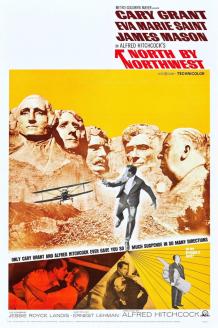Come see this classic film by Alfred Hitchcock on 35mm film as part of our "Classic Film Series".
‘North by Northwest’: The Hollywood Reporter Original 1959 Film Review
Jack Moffitt, originally published on June 30, 1959
On July 17, 1959, Alfred Hitchcock unveiled his latest suspense thriller, North by Northwest, in theaters in Los Angeles. The film, starring Cary Grant and Eva Marie Saint, was nominated for three Oscars at the 32nd Academy Awards. The Hollywood Reporter’s original review is below.
A packed audience at the preview loved every cliff-hanging moment of this Alfred Hitchcock thriller. Basically, it’s another cloak-and-dagger chase and, for the most part, it is done with tongue-in-cheek. But Hitchcock is such a master of suspense that not many frames have passed before the audience has achieved complete identification with the characters and is knowing the thrill of vicarious fear and the shared pleasures of love and passion. The story may not be real but Hitchcock makes it seem real.

Of course, Hitchcock doesn’t achieve this triumph entirely by himself. Cary Grant, as a glib Madison Avenue huckster, mistaken for a Central Intelligence agent by a group of Iron Curtain spies, is simply great. He delivers a marvelous series of close-ups when the heavies, after forcing a bottle of bourbon down his throat, place him in a Mercedes convertible and head him for a cliff. Struggling with double vision and drunkenness — with eyes now bugged out with horror and now drooping and glazed, he gets a laugh and a shriek out of every grimace.
Later, while standing alone and forlorn on a bleak, and seemingly limitless Indiana prairie, he keeps you enthralled by doing nothing at all. Still later, while endeavoring to dodge an airplane that is dusting crops with a poisonous spray, he arouses more fear than a dozen movie Joan of Arcs being burned at the stake.
The women will be attracted to him every minute, particularly in a hospital scene when he strides about clad only in a bath towel. Patricia Cutts gets the biggest of the many laughs in the film with a two-word part. She’s a hospital patient. When Grant sneaks through her room, she yells “Stop!” (in a voice that means “Stop!”). Then she puts on her glasses, takes a good look at him and says, “Stop?” (in a voice that means “Don’t stop”).
Hitchcock takes Eva Marie Saint (hitherto mostly cast as a waif type) and turns her into an ice-covered volcano in the love passages. By endowing her with a beckoning almost unattainable glamour, he’s done for her what he did for Grace Kelly in Rear Window and Dial M for Murder. “It’s much better than flying,” Grant murmurs on one occasion when coming out of her arms. Throughout the script, Ernest Lehman has supplied the stars with a series of scintillating and unstrained-for bright lines.
The plot evolves from the efforts of C.I.A. chief (Leo G. Carroll) to force the hand of a group of enemy agents by placing a mythical “Mr. Caplan” on their trail. Hotel rooms are booked for “Mr. Caplan” wherever the spies are known to be active and luggage is placed in them. The espionage chief (James Mason) rises to the bait by having “Mr. Caplan” paged at New York’s Plaza Hotel (all settings in the picture are authentic locations). By coincidence, Grant speaks to the paging bellboy and is caught up and involved in a fight for life with shadowy forces. At times everyone thinks he is crazy but, like Hamlet, he is “but mad north-north-west”; when the wind is southerly he knows “a hawk from a handsaw.”
The chase takes him to the UN where a man (Philip Ober) is murdered. A fugitive aboard the Twentieth Century Limited, Grant explains his ducking of the cops to the suspiciously sympathetic Miss Saint by saying “Seven parking tickets.” There’s more turning and twisting at Chicago’s La Salle Street station where Grant astounds the men’s room by shaving with Miss Saint’s tiny feminine razor. The final showdown occurs on Mt. Rushmore with good guys and bad guys pursuing each other over Borglum’s gigantic sculptured features of four presidents.
Hitchcock’s storytelling supplies a number of devices that could be studied with advantage by students of screen literature. He lets the audience in on the fact that there is no “Mr. Caplan” at the precise moment when it is getting tired of being bewildered. Stressing human values rather than gimmicks, he doesn’t introduce the “weenie” (a ceramic figure containing microfilm) until the latter part of the picture. By letting us see a minor heavy (Adam Williams) drawing on a pair of black gloves, he alerts us to the fact a crime is contemplated without disclosing its nature. Only after Ober has done a terrific laugh-getting takeum in the midst of a normal conversation does the camera pull back to reveal that a knife has been thrown into his back. Another offbeat note is struck by giving the hero a bird-brained gold-digging mother (portrayed with fine superficiality by Jessie Royce Landis).
The photography by Robert Burks and the special effects by A. Arnold Gillespie and Lee LeBlanc are outstanding, especially in the prairie sequences. George Tomasini’s editing of the chase on Mt. Rushmore also is tops. So is Bernard Herrmann’s score. This film is pure entertainment.



